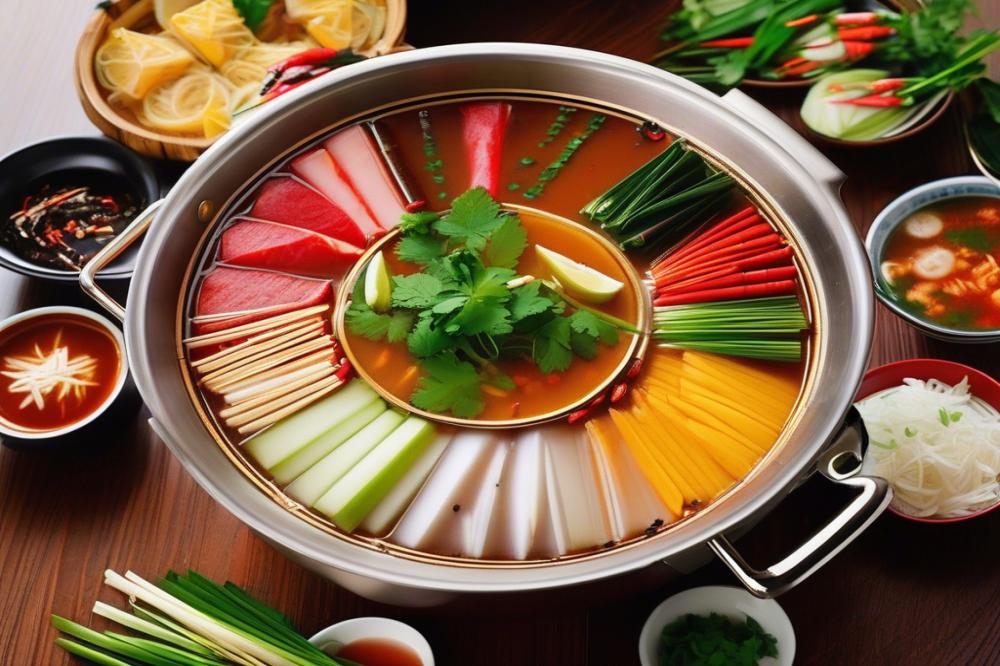Introduction
Vietnamese Hot Pot represents a lively and interactive dining experience that is deeply rooted in the culture of Vietnam. This dish brings family and friends together, filling tables with a variety of fresh ingredients to cook in a bubbling broth. Traditionally, it encourages conversation and connection while everyone contributes to the meal. A steaming pot at the center of the table is a common sight during special gatherings in Vietnamese homes.
Emphasizing family-style dining, this cuisine is all about sharing. Diners often gather around one hot pot, selecting from an array of meats, seafood options, and vibrant vegetables. Each person has a hand in choosing their preferred hot pot ingredients, fostering a sense of unity. Traditional meals often revolve around this social aspect, where the flavors blend and elevate the dining experience.
This guide will provide you with insights into creating your very own Vietnamese Hot Pot. Expect to learn about cooking techniques, how to prepare a flavorful broth recipe, and numerous dipping sauces. You’ll discover the best cuts of beef slices, as well as various seafood choices, to enhance your hot pot feast. Additionally, knowledge about essential Vietnamese herbs will be shared, allowing you to customize the flavors to your liking. This guide aims to make meal preparation enjoyable and easy, bringing the heart of Vietnam to your kitchen through a delicious Lẩu recipe.
Vietnamese Hot Pot: A Culinary Delight
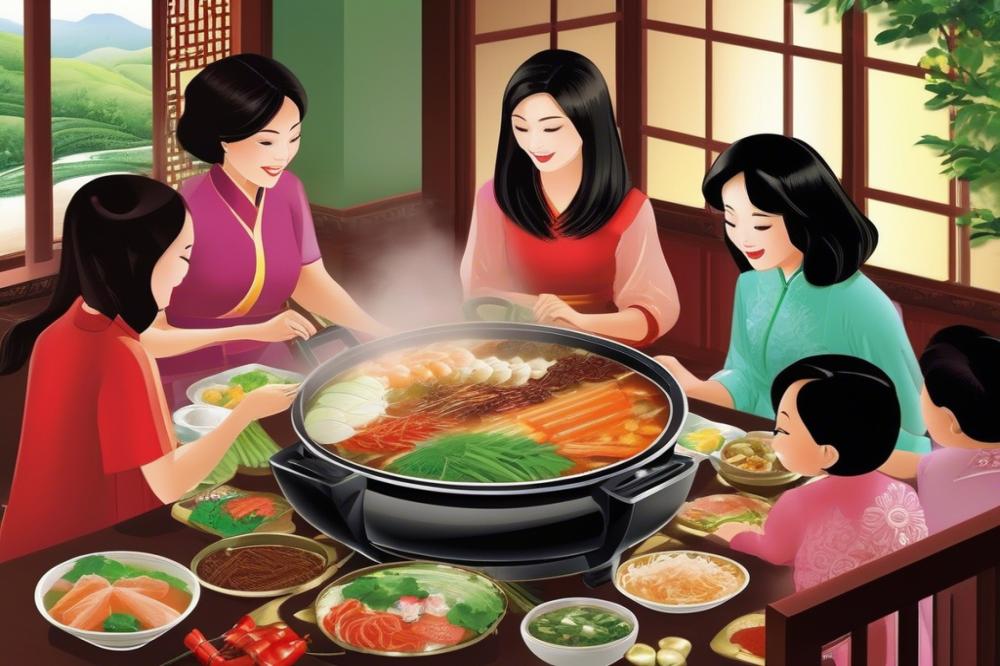
Hot pot is an essential part of Vietnamese cuisine. Its origins can be traced back centuries, influenced by regional cooking styles and cultural exchanges. This dish brings people together, combining various ingredients into a single pot of flavorful broth. Vietnam’s unique take on hot pot reflects its rich history and diverse flavors.
When preparing a meal, fresh ingredients are vital. Selecting quality hot pot ingredients can make a significant difference in taste. Crisp vegetables, tender beef slices, and a variety of seafood options contribute to a vibrant dining experience. Many families also use an array of Vietnamese herbs to enhance flavors and add freshness to each bite.
Interactive Cooking
Cooking techniques used in hot pot emphasize participation. Diners often take turns cooking ingredients at the table. This interactive style of meal preparation allows everyone to customize their bowl with different flavors and textures. Guests dip fresh items into bubbling broth, watching as they transform into delicious morsels.
Broth recipe choices are plentiful. Some prefer a spicy and rich broth, while others enjoy mild and fragrant versions. Adding dipping sauces elevates the experience further. Each sauce complements the ingredients beautifully, allowing for full flavor exploration with each bite.
Dining Experience and Social Aspects
The dining experience is often family-style, promoting sharing and conversation. Friends and family gather around the table, creating a warm, welcoming atmosphere. As everyone participates, laughter and stories flow, adding to the enjoyment of the meal. This communal aspect truly makes hot pot special.
Hot pot is a feast for the senses. The colorful arrangement of fresh produce and meats is visually inviting. The sounds of bubbling broth and sizzling ingredients create an exciting ambiance. Enjoying a hot pot meal not only satisfies hunger but also strengthens bonds among those who share it.
Ingredients for Vietnamese Hot Pot
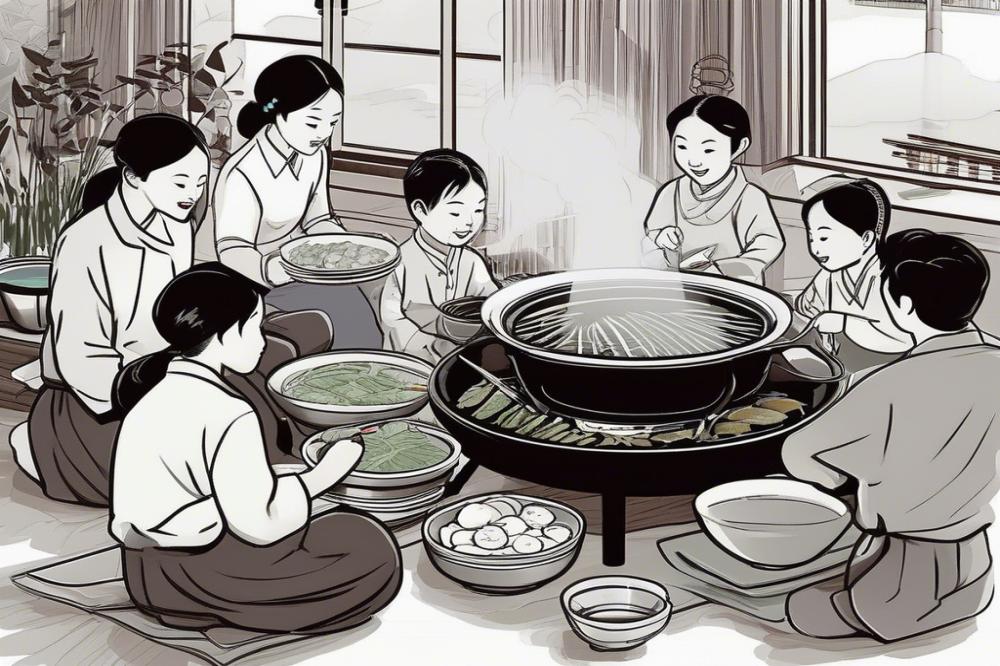
Making delicious hot pot at home requires a variety of fresh ingredients. Here’s a list of essential hot pot ingredients to get you started.
Broth Base:
- Chicken stock or beef stock – 4 cups
- Water – 4 cups
- Lemongrass – 2 stalks, bruised
- Ginger – 1 thumb-sized piece, sliced
- Thai chili peppers – 2-3, optional for spice
- Fish sauce – 3-4 tablespoons for flavor
This broth recipe forms the foundation of your dish. The combination of lemongrass and ginger offers aromatic notes, while fish sauce adds depth.
Proteins:
- Thinly sliced beef (e.g., ribeye) – 500 grams
- Seafood options (e.g., shrimp or squid) – 500 grams
- Firm tofu – 1 block, cubed
Beef slices and seafood options are excellent choices. They cook quickly and soak up the flavor of the broth. Tofu provides a vegetarian option that complements the proteins well.
Vegetables:
- Bok choy – 200 grams, chopped
- Mushrooms (e.g., shiitake, enoki) – 200 grams, sliced
- Fresh herbs (e.g., cilantro, basil) – 1 bunch each, for garnish
Fresh vegetables bring color and nutrition to your meal preparation. Vietnamese herbs enhance the taste, making each bite refreshing.
Noodles:
- Rice noodles – 200 grams, soaked in warm water
Noodles are a hearty addition to your hot pot. They absorb the flavors from the broth, creating a satisfying contrast.
Dipping Sauces:
- Hoisin sauce – to taste, for sweetness
- Chili sauce – to taste, for heat
Dipping sauces add another layer to your dining experience. They allow you to customize each bite, making family-style dining even more enjoyable.
Nutritional Information for Key Ingredients:
Knowing the nutritional benefits of these ingredients can enhance your meal planning. Lean proteins from beef and seafood provide essential amino acids. Tofu offers a good source of plant-based protein. Fresh vegetables are packed with vitamins, while herbs contribute antioxidants. Rice noodles provide carbohydrates, giving you energy. This mix results in a balanced, flavorful hot pot that everyone can enjoy.
Cooking Techniques for Perfect Vietnamese Hot Pot
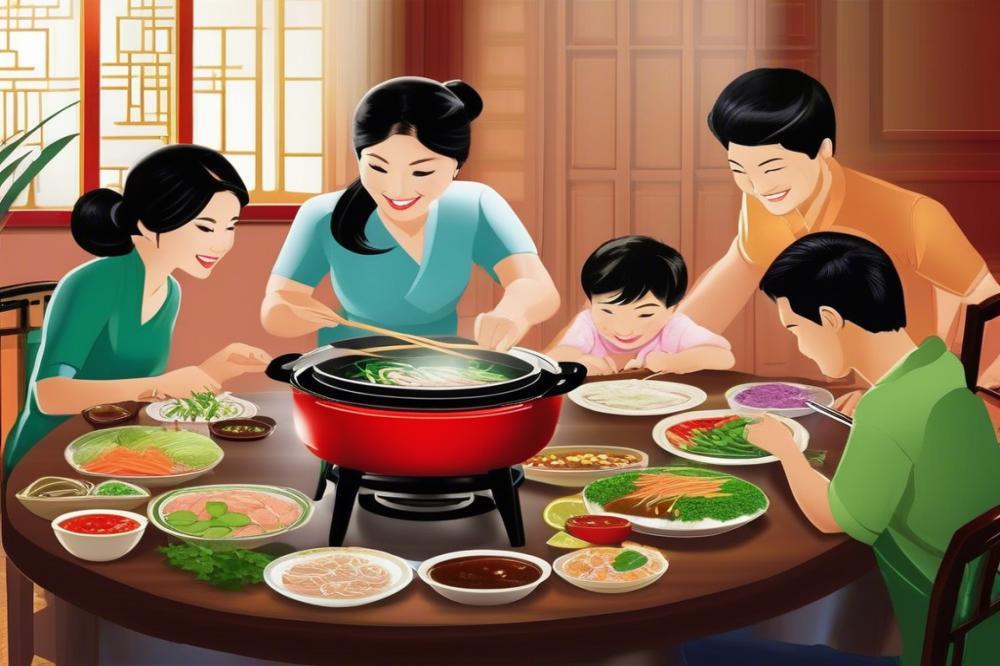
How to Prepare the Broth: Step-by-Step Instructions
To create a delicious broth, start with a base of water. Place beef bones in a large pot and cover with water. Bring this to a boil, then reduce heat to a simmer. Skim any foam that surfaces. Toss in aromatics like onion, ginger, and garlic. Let these simmer for about an hour. Afterward, remove the bones and strain the liquid. This leaves you with a clear, flavorful broth. Add seasonings, such as fish sauce and salt, according to your taste. You can also include spices like star anise or cinnamon for depth.
Tips for Balancing Flavors in the Broth
Balancing flavors in your broth is crucial. A good broth should not be overly salty or bland. Fish sauce adds a unique umami flavor, but use it sparingly. Add a bit of sugar to round out the taste. Fresh herbs like cilantro or Thai basil can enhance the aroma. Adjust the acidity by adding lime juice before serving. Taste as you go to find the right mix. Remember, everyone has different preferences, so feel free to experiment.
Cooking the Proteins and Vegetables at the Table
Vietnamese hot pot is all about communal cooking. Prepare an array of hot pot ingredients, including beef slices, seafood options, and various vegetables. Guests can choose their favorites and cook them in the bubbling broth. Use thin slices of meat, as they cook quickly. Leafy greens and mushrooms are excellent additions. Remember to provide dipping sauces on the side for added flavor. Peanut sauce or nuoc cham are popular choices. This enhances the experience and allows for personal touches.
Importance of Timing and Maintaining Broth Temperature
Timing plays a significant role when cooking at the table. Once the broth is ready, keep it at a simmer. Replenish the broth as needed to maintain the temperature. If it cools down too much, cooking will slow and flavors may be lost. Encourage everyone to cook their protein and vegetables for just a couple of minutes. This way, everything stays fresh and warm. Family-style dining creates a lively atmosphere that enhances the meal. Watching each other cook adds fun to the experience.
Crafting the Ideal Dipping Sauces
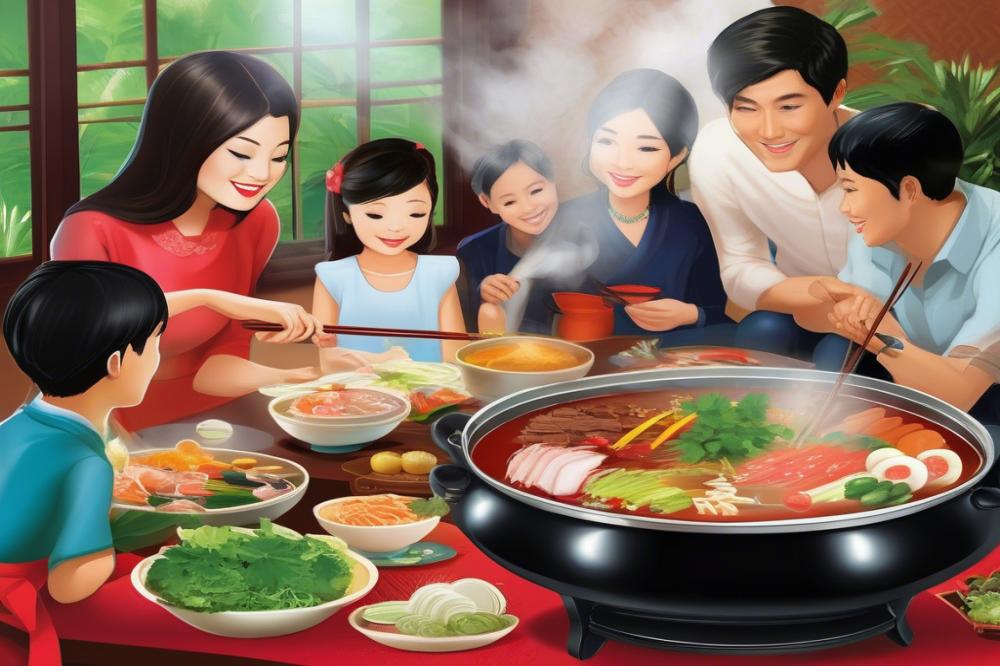
In Vietnamese cuisine, dipping sauces play an essential role in enhancing flavors and making each bite even more enjoyable. Various sauces are available, each offering a different taste experience. Let’s explore some common Vietnamese dipping sauces along with their ingredients.
Common Vietnamese Dipping Sauces and Their Ingredients
Nuoc Cham stands out as a classic. This sauce combines fish sauce, lime juice, sugar, garlic, and chopped chilies. Ingredients like vinegar and water can also be added to balance the flavors. Another popular choice is Hoisin sauce, often paired with peanut butter for a creamy texture. Miso, sesame, or even a touch of Sriracha might find their way into these mixtures.
For those who prefer a tangy kick, a simple mixture of vinegar, soy sauce, and fresh cilantro works wonders. Add some sliced ginger or toasted sesame seeds for an extra zing. The variety available allows for personalized creations based on what flavors you love most.
Simple Recipes for Homemade Dipping Sauces
Crafting your dipping sauces at home is straightforward. To make Nuoc Cham, mix 1/4 cup of fish sauce with juice from one lime, 1 tablespoon of sugar, and one finely minced garlic clove. Stir until the sugar dissolves, and add chopped chilies to suit your spice preference.
For an easy Hoisin-peanut sauce, blend together 1/4 cup of Hoisin sauce with 2 tablespoons of peanut butter, a splash of vinegar, and a dash of water. Adjust the thickness by adding more liquid if needed. This dipping sauce pairs beautifully with shrimp and spring rolls.
Suggestions for Pairing Sauces with Different Proteins and Vegetables
Vegetables also deserve attention. Fresh herbs such as Thai basil or mint add refreshing elements when dipped in these sauces. Try the tangy vinegar sauce with mushrooms or leafy greens for a delightful balance. Creating your perfect combination can turn a simple meal into an exciting feast.
Experiment and adjust the proportions of ingredients based on your preferences. Use this opportunity to engage with family-style dining. Gather everyone around and let them customize their own dipping sauces. This interaction not only makes meal preparation fun, but also deepens connections through shared experiences.
Meal Preparation and Family-Style Dining Experience
Setting the Table for a Hot Pot Meal
Creating an inviting atmosphere is the first step in a successful hot pot gathering. Start with a large table, ideally round, where everyone can reach the pot easily. Lay out placemats for each guest, adding a touch of warmth to the meal. Place chopsticks, spoons, and small bowls at each setting for easy access. Consider using vibrant colors that reflect the lively spirit of Vietnamese cuisine.
Arranging Ingredients for Easy Access
Organize hot pot ingredients on the table for a visually appealing arrangement. Arrange slices of beef and colorful seafood options on large platters. Use small bowls for fresh Vietnamese herbs like basil and mint, as well as dipping sauces. Make sure to keep the raw items separate from cooked ingredients to maintain a safe cooking environment. This setup allows guests to pick and choose what they would like to cook.
Tips for Involving Family and Friends in the Cooking Process
Engaging everyone in the cooking process can enhance the fun of the meal. Assign each guest a task, like marinating meat or preparing the broth recipe. Encourage everyone to share their favorite hot pot ingredients with one another. This not only helps with meal preparation but also opens a dialogue about personal tastes and preferred cooking techniques. Even novice cooks can easily join in, making this a great way to bond.
Emphasizing the Communal Aspect of Hot Pot Dining
Vietnamese hot pot is all about sharing and coming together. Encourage everyone to take turns adding ingredients to the pot. This tradition becomes a talking point, sparking conversation as the broth bubbles and smells waft through the air. Guests can also gather around the table to dip their cooked items in the sauces, creating a flavorful experience. The communal aspect fosters a sense of togetherness, making the meal memorable.
Wrapping Up the Vietnamese Hot Pot Experience
Making Vietnamese hot pot at home can be a delightful adventure. The process is filled with joy and the aroma of simmering broth brings warmth to your kitchen. Gathering fresh ingredients and preparing them together turns cooking into a fun event.
Feel free to experiment with different hot pot ingredients. Perhaps try adding your favorite seafood, mushrooms, or a mix of fresh vegetables. Each selection can bring something special to the table. Don’t hesitate to make it your own. Traditional recipes are wonderful, but your creativity can lead to surprising flavors.
Enjoying this meal with family and friends makes the experience even better. Sharing stories while cooking together creates lasting memories. Each bite not only satisfies hunger but also enriches relationships. Invite loved ones to join; laughter and conversation around the pot will enhance the evening.
In conclusion, making this dish is more than just a meal. It’s a celebration of Vietnamese cuisine that brings people together. Let your imagination guide you as you create a comforting feast everyone can appreciate. Dive into the adventure of hot pot and savor every moment spent with those you cherish.

